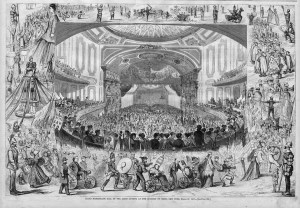After the infamous Astor Place Riot in May of 1849, New York was left without a dedicated opera house. A handful of investors decided to resolve the situation by building the Academy of Music which opened on this day in theatre history–October 2–in 1854. The structure sat 4,000, complete with private boxes for the city’s wealthiest. Located on East 14th Street and Irving Place–just off Union Square, in what was one of the city’s toniest neighborhoods–the theatre served as the hub of New York society until the early 1880s. But its role as an opera house was soon modified as the managers sought every opportunity to keep the facility afloat. It not only hosted operas, but plays, civic functions, political rallies, and industrial fairs.
Just after the Civil War, in an attempt to expand the entertainment offerings, the theatre developed a rather peculiar amusement for which it was most remembered–the so-called “French Ball.” Some of the younger members of the city’s rapidly expanding nouveau riche, enriched by the war and hungry to explore their own tastes in “culture,” formed a private club devoted to encouraging the finer things in life and importing the most current European trends. They called themselves the “Cercle Française de l’Harmonie” and they introduced a new form of “continental amusement” to the city–the French Ball. Initially, these were merely fancy dress balls, often masked, and with a charitable intention. But over time, the Academy’s “French Balls” evolved into something else altogether–ribald soirées in which New York’s wealthiest mixed and mingled (to put it politely) with the city’s finest prostitutes, who were not always required to dress for the occasion–in fact, the more scantily clad the better. Throughout the late 1860s and 70s, the Academy’s French Balls were one of the highlights of New York society’s annual calendar and were lustfully covered by the press in lurid detail, describing activities that were nothing short of a Gilded Age orgy.
By 1883, the city’s elite decided that the Academy was no longer a suitable place for such refined performances like opera, and the Metropolitan Opera House was opened at 1411 Broadway as a way to draw New York society away from the Academy’s unsavory reputation. Within a few years, the French Balls ceased and by 1888, the Academy of Music was converted into a vaudeville house until it was demolished in 1926 to make way for the Consolidated Edison Company Building. The building’s odd and unusual history is often overlooked by theatre historians, but it represents one aspect of the varied forms of entertainment that defined the 19th century in New York. And it certainly enhanced the meaning of “fancy ball” in ways not normally expected from the apparently puritanical 19th century Americans. More importantly, we have the French Balls to thank for the creation of the New York Metropolitan Opera.

